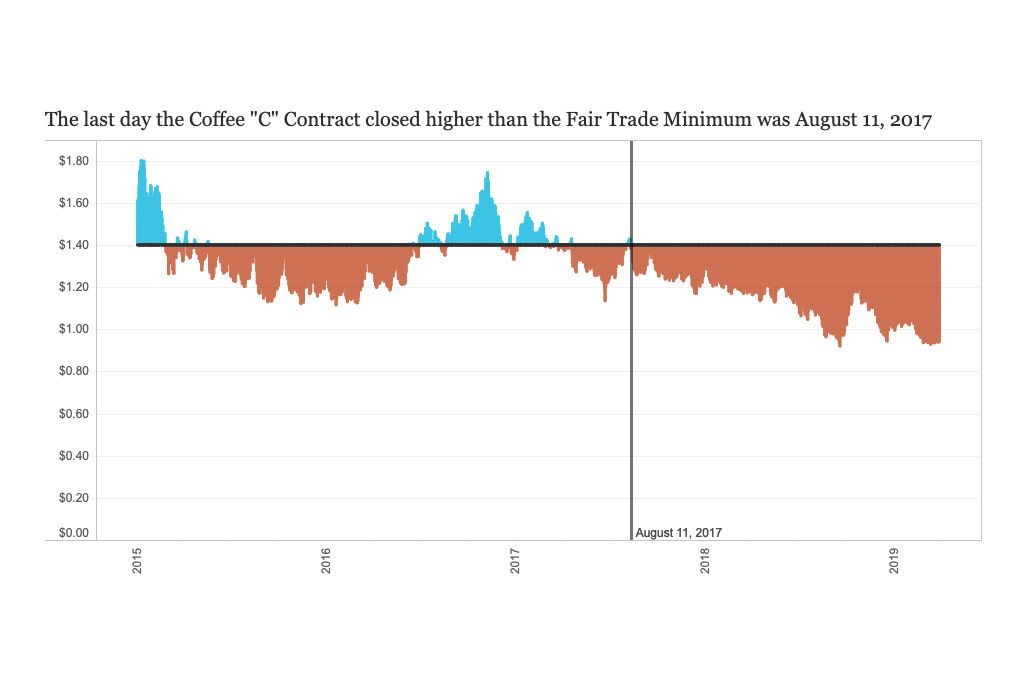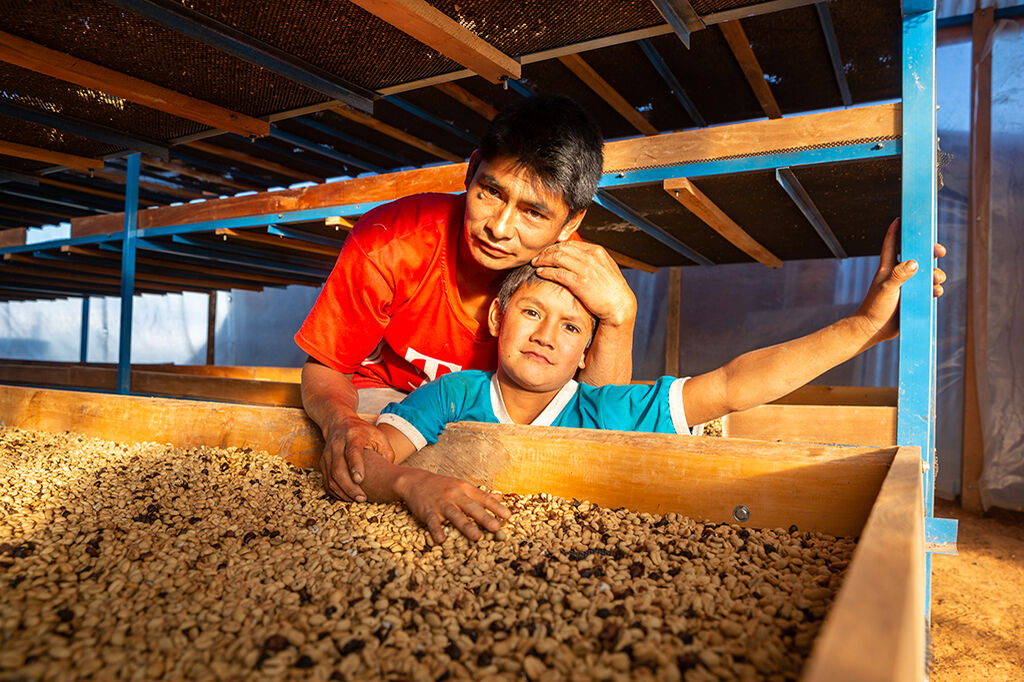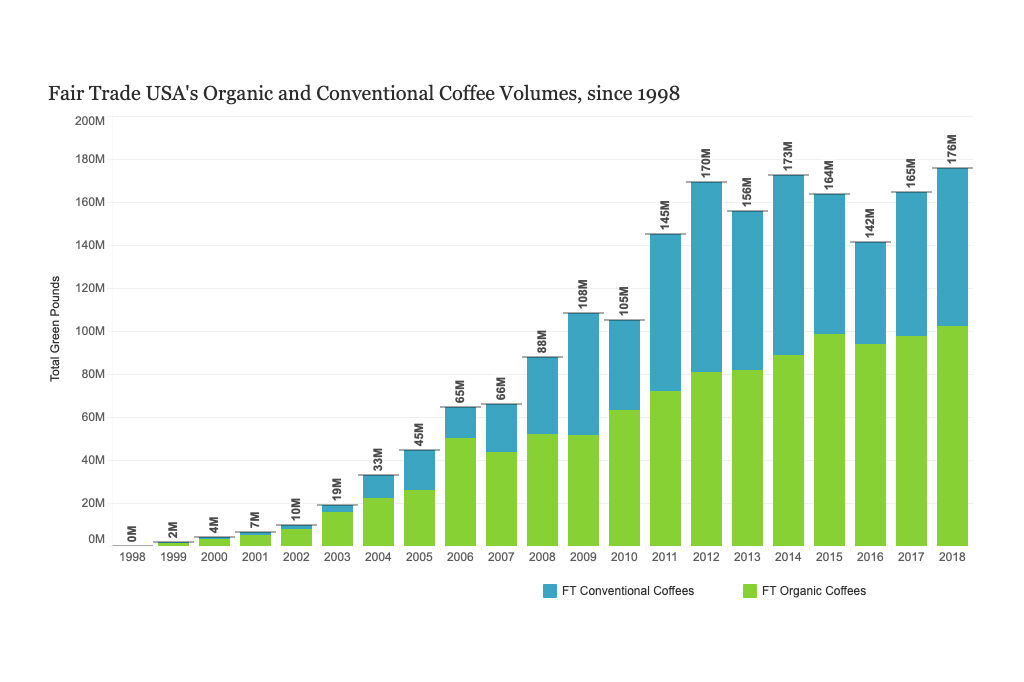Editor’s note 9/3/2020: The coffee crisis reported on in this article is, unfortunately, more relevant than ever. The global pandemic has made a bad situation worse for many people whose livelihoods depend on coffee. Coffee prices, which were already well below the cost of production in most countries at 13-year lows, are expected to become more volatile as the pandemic unfolds. Coffee farmers are deeply concerned about the future of their crops due to decreased commercial demand from restaurants, offices, hotels, etc. To top it off, the nature of the coffee industry leaves farmers especially vulnerable to income and food insecurity should a harvest not go as planned. This is currently a significant risk because labor shortages in most coffee-growing regions have resulted in delayed and reduced harvests as farmers have not been able to pick all of their coffee. For these reasons, it’s more relevant and crucial than ever to understand and seek out fair trade coffee.
We are at a critical moment in the coffee industry. The New York Coffee “C” Contract price—which is basically the benchmark for determining price between producers and buyers—dropped from around $2 a pound in 2014 to 89 cents in 2019—a more than 50 percent drop and a 14-year low. At this price, coffee farmers are unable to cover even the most basic costs associated with coffee production.
In other words, coffee at its current price means producers lose money with every sale, debt piles up, and communities go hungry—even as many sell their coffee beans to some of the world’s best-known specialty coffee brands and retail prices for specialty coffee rise.
For many coffee farmers, conditions seem so hopeless that they are converting their farms to illicit crops like coca or abandoning farms altogether to seek better livelihoods in other countries. Forbes reported that Guatemala is now the single largest source of migrants attempting to enter the United States, a major reason being the decline in coffee prices, which has caused many farmers to believe their circumstances are too desperate to remain in their country.
We’ll only see more and more of this if prices stay this low. With fewer coffee producing regions, we’ll start to see less quality and diversity in the coffees we are able to access.
When we opened our doors 20 years ago, there was a similar pricing crisis facing coffee farmers. In fact, it is a major reason Fair Trade USA® exists today. Through the years, we’ve continued to implement and enforce rigorous fair trade standards which drive protection of fundamental human rights, safe working conditions, money for community development, democratic organization, ability to improve product quality and capacity, access to new markets, and strong supply chain relationships. Fair trade has been a lifeline to many coffee farmers when the market fails them, and again it’s more important than ever.
A major goal for us is to provide information to help consumers and businesses make informed, ethical purchase decisions, and one way to do that is by dispelling misinformation about fair trade coffee that has come up over the years. This article aims to clear some of that up.
Myth #1: Fair trade is only valuable for businesses.
We know that some people view fair trade as a nice “pat on the back” for large companies and multi-national corporations needing to satisfy their sustainability goals, or perhaps just another middleman between you and the source of your coffee. This perspective may originate from the quick growth of the fair trade model in the 2000s and the incorporation of major brands and retailers as more and more consumers began to demand ethically responsible and sustainable coffees. Sure, fair trade is valuable for businesses to the extent that it relies on purchases—if there were no purchases on fair trade terms there could be no fair trade impact. But what sets fair trade apart from other certifications is that it was established as part of joint effort of producers, consumer rights advocates, and the industry coming together to envision a better, more sustainable way of doing business. The standards are driven in large part by small producer organizations to balance higher incomes with market share.
Myth #2: The fair trade coffee price doesn’t really help farmers.
Coffee farmers and farm workers across the globe face many challenges: extreme poverty, food insecurity, vulnerability to climate change and diseases, low and volatile market prices, intermediaries and lack of price and information transparency, unregulated working conditions and labor rights abuses, and generations leaving farming in search of a better life. Fair trade empowers farmers and workers to address these challenges and build strong businesses and thriving communities through three main avenues: our standards, the enforcement of a minimum price paid directly to the Certificate Holder (usually a cooperative), and Community Development Funds that the cooperative members invest in their communities through democratic decision-making.
Fair Trade Minimum Price
The price for unroasted (green) coffee is determined by a global commodities market. This price fluctuates daily, has no basis on the actual costs to produce that coffee, and historically has been a way to protect the interests of buyers in the global north.
The Fair Trade Minimum Price for coffee was last set in 2011 according to a global benchmark on production costs. The standard minimum price for washed Arabica unroasted coffee is $1.40 per pound, or $1.70 per pound if the coffee is also certified organic. If the market price falls below the Fair Trade Minimum Price, as it did in August 2017 and where it has remained since, then producers who sell their coffee on fair trade terms have the assurance of knowing they will receive at least the minimum price for their coffee. When times are good and the market price is above the minimum price, then producers can of course sell their coffee above that price. Fair trade is the only mainstream model that does this (guarantees a minimum price to help coffee producers through hard times).
As Paul Hicks from Catholic Relief Services points out in his article “Extreme Price Volatility Undermines the Coffee Sector,” price volatility is harmful in and of itself, making it very difficult for coffee farmers to plan and manage their farms and investments. Farmers with stability and confidence are more likely to invest in productivity and coffee quality, hire farm workers and pay them fairly, and at the most basic level, be able to feed and provide for their families.

Community Development Funds
For every pound of green coffee sold on fair trade terms, the producer earns an additional 20 cents per pound that goes directly into a Community Development Fund. From there, cooperative farmer members democratically decide how to use these funds in their local community to improve their lives and meet their unique social, environmental, and economic needs that are not being met by the local government or financial sector. For a cooperative that sells most of their coffee on fair trade terms, this could mean an additional $100,000 or more each year to invest in services to communities, workers, or farmer members, and investments in the infrastructure of their organization. These investments empower coffee farmers to become more resilient in the face of mounting challenges which threaten coffee production, like climate change, by helping farmers earn additional income and access networks of information. Last year, Fair Trade Community Development Funds generated $35 million of additional income for coffee producers—the highest amount in a single year in our existence as an organization.
Myth #3: Direct Trade is better because fair trade doesn’t focus on quality.
Actually, fair trade as a system does help to support and encourage investments in quality. Coffee cooperatives join the fair trade system starting off with a range of different capabilities when it comes to quality assurance, internal procedures, ability to segment coffees, and technical support. As these groups participate in the fair trade system, they are required to invest at least 25 percent of the Fair Trade Community Development Funds that they earn into quality and productivity initiatives. In fact, we see many go above and beyond this requirement, with investments in these areas hovering around 50 percent in recent years. As cooperatives build up their capabilities to support farmers with trainings on agricultural best practices and investment in new processing technologies and techniques, quality improves. As quality improves, new business opportunities open up. In this way, fair trade helps cooperatives make the needed investments to become sustainable businesses and allow for the conditions necessary to sell quality coffees into a market that requires consistency and innovation.
Some specialty coffee companies have touted that direct trade is better than fair trade, but the two are not mutually exclusive and coffee roasting companies can engage in both. Fair trade coffees can be directly traded, meaning that buyers and producers can have long-term relationships and negotiate higher than Fair Trade Minimum Prices for high quality coffee. On the flip side, many direct trade coffees are from fair trade cooperatives. Both methods can involve forming long-term relationships with the producers and paying higher than market price based on quality. For coffee roasters, fair trade and direct trade supply chains are founded on transparency—ensuring that the product they purchase has an identity and supports the people behind its production by directly investing with their producer partners and their communities and strengthening supply chains. Fair trade achieves this through third party evaluation and certification with a clear set of standards and processes for auditing, whereas direct trade is a concept that encourages roasters to develop more direct relationships with coffee producers but has no single or set definition of standards.
As Chris Davidson of Atlas Coffee Importers said, “Without standards and third-party verification ‘direct trade’ could mean anything or nothing at all.”
Unfortunately, many brands advertising direct trade coffees have never visited these producers in person, don’t have a relationship with their coffee producers, and/or don’t have a verified method to ensure that the additional prices they’re paying for high quality coffees are actually getting to the farmers that are putting in the additional work to produce these coffees.
For these reasons, Fair Trade USA promotes fair trade products as a way to provide a reputable third-party guarantee, and we encourage our coffee partners to develop direct relationships with their producers at origin. For consumers, fair trade is a simple and clear way to support producer communities across the globe, shop their values, and vote with their dollar for a better world.

Pueblo Libre, Chirinos, San Ignacio, Cajamarca, Peru. July 18th, 2019.
Myth #4: Fair trade doesn’t focus on environmental sustainability.
We believe that compensating farmers for the work they do is the first step toward achieving environmental goals. Farmers can’t go hungry for the sake of putting healthy environmental practices in place. Once farmers are getting paid adequately, they have the means and health to invest in the land they care for just as much as we all do. That said, Fair Trade USA’s Agricultural Production Standard does include a range of environmental protections with criteria related to efficient water usage; protection of biodiversity, forests, and waterways; prevention of use of GMOs and reduction of harmful pesticides; utilization of techniques for integrated pest management and soil health; and waste disposal management. In addition, fair trade’s is the only voluntary sustainability standard that provides a formal premium for organic certification. As mentioned already, the Minimum Price is 30 cents higher for organic fair trade coffee. Every year since 2013, more organic fair trade coffee has been certified than conventional coffee. Between 1998 and 2018, Fair Trade USA certified around 1.06 billion pounds of organic coffee compared to 780 million pounds of conventional.
Finally, many coffee cooperatives invest their Community Development Funds into environmental projects such as sanitation, subsidizing organic fertilizers, waste water treatment, or training on good agricultural practices that minimize negative environmental impacts.

Myth #5: There isn’t enough fair trade coffee available.
Quite the opposite, actually! Supply of Fair Trade Certified coffee is abundant; it’s just a matter of needing buyers. In 2018, Fair Trade USA certified 176 million pounds of Fair Trade Certified coffee and there are more than 800,000 coffee farmers in the fair trade system, yet only 35 percent of available production was sold on fair trade terms.
The movement to source more sustainable coffee is being led in large part through the Sustainable Coffee Challenge, an industry-wide initiative to make coffee the world’s first 100 percent sustainable commodity. Target has committed to converting all of its Archer Farms brand coffee to fair trade by 2022, while, two more retailers recently made big commitments: Albertsons announced their O Organics coffees will be Fair Trade Certified, and Williams Sonoma shared that they will transition 100 percent of their branded coffees to fair trade in coming years. More than 100 companies in retail, food service, and beyond have stepped up to make similar commitments. Together, these will help to increase market access for farmers looking to sell their coffee on sustainable terms. For coffee drinkers, it means greater availability of fair trade goods and better communications about the impacts of the model.
So, what does all this mean for you? If you’re a coffee drinker, look for our label on your coffee. Fair Trade Certified coffee is available at every major grocery store in the country, so shop where you can find it and request it where you can’t.
If you work in the coffee industry, learn more about sourcing Fair Trade Certified coffee.
Together, and only together, we can set a change into motion.